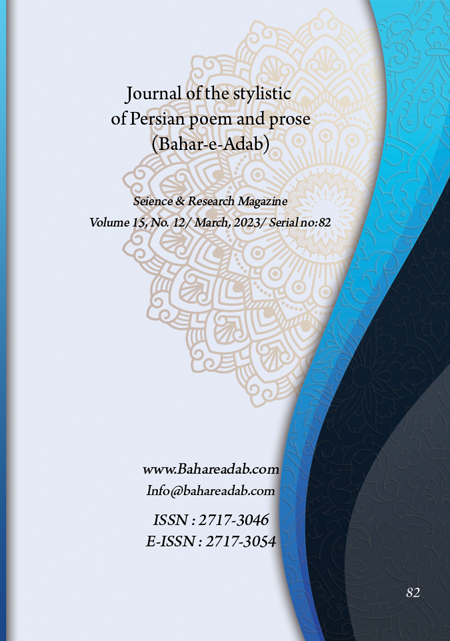- Count View : 341
- آدرس کوتاه شده مقاله: https://bahareadab.com/article_id/1418
- کد doi مقاله: Doi: 10.22034/bahareadab.2023 .15 .6825
Journal of the stylistic of Persian poem and prose
volume Number 15،
number In Volume 12،
،
issue Number 82
Formalistic reading of a lyric by Rumi and explanation of the crystallization of Rumi's thought in language
Fatemeh Rezaei , Ahmad Amin (Author in Charge), Ali Mohammadi Asiabadi
Abstract
BACKGROUND AND OBJECTIVES: When the elements and components of a literary work are examined and how they are related to each other and their relation to the general structure of the work is retrieved, a basic (formalist) form reading is performed. It is with such a reading that we can talk about the degree of bonding of the components of the work (horizontal and vertical bonds). In this article, the form and structure of a lyric by Rumi has been read with the following information (with the help of in-text symbols):
A word that rises from the soul of the soul to veil the gem and the lips of the sea, the tongue of the veil
METHODOLOGY: It is a descriptive-analytical research method that examines Ghazal No. 921 from Shams Tabrizi"s KOliat, edited by Badi ol-Zaman Farozanfar.
FINDINGS: The feature of this sonnet in all verses is that the face is a veil and at the same time a means of expressing meaning. The world of existence is the world of forms and meanings, and forms are veils of meanings, and at the same time meaning manifests itself in the face. To reach the meaning, you have to go beyond the surface. Of course, the absolute meaning cannot be understood and there is always one curtain behind another curtain, and it is only in death and silence that we understand the meaning. The theme of the contrast between form and meaning and the contrast between pairs of their synonymous words can be seen in all the verses of Ghazal.
CONCLUSION: The link that can be seen between the verses of this ghazal has created an organ-like structure and the overall structure of this ghazal evokes one of the key oppositions of form and meaning in Rumi"s thought, "wave and sea". For Rumi, the content is the tool for the evolution of the form, and the form is the material for the emergence of the truth of meaning. Rumi"s poetry boils from inside him and finds its shape and form according to the type of boiling. However, due to the reliance on form, the new critique cannot be a suitable critique for mystics who are free from form.
Keyword
Rumi
, face
, meaning
, formalist critique
, sea
, boiling poetry
- Bertens, Hans. (2004). Basics of literary theories. Translated by Mohammad Reza Abul Qasimi. Tehran: Mahi, p. 57.
- Eliot, T. S. (1971). Hamlet and His Problems; H. Adams. (ed.). New York.
- Elliott, T. S. (1982). The utility of poetry and the utility of criticism, translated by Yusuf Awad, Beirut: Dar al-Qalam.
- Emami, Nasrollah. (2006). Basics and methods of literary criticism. Third edition, Tehran: Jami, p. 217.
- Fotuhi, Mahmoud. (2001). "Analysis of the image of the sea in Masnavi". Humanities Research Journal of Shahid Beheshti University, No. 31, pp. 1-24.
- Ghazali, Abu Hamid. (without). Revival of Ulum al-Din. Damascus: Maktaba Abdul Vakil al-Darubi, vol. 2, p. 249, and vol. 3, pp. 109-110.
- Hassan Lee, Cavus. (2008). "A formalist reinterpretation of a sonnet by Biddle". Literary criticism (Institute of Humanities and Cultural Studies), (2) 1, pp. 38-29.
- Mirsadeghi, Maimanat. (1997). Dictionary of poetic art, second edition, Tehran: Mahnaz.
- Mohabbati, Mehdi. (2010). from meaning to form (2c), Tehran: Sokhan.
- Mohammadi Asiabadi, Ali. (2008). Hermeneutics and symbolism in Shams' sonnets. Tehran: Sokhan, p. 33.
- Mohammadi Klaser, Alireza. (2013). "The role of interpretation in the expansion of the language of mysticism". Mystical literature researches (Gohar Goya), (2) 8, pp. 122-99.
- Moulavi Jalaluddin Mohammad Balkhi. (2004). Generalities of Divan Shams (2c). According to the correction of Badi Al-Zaman Forozanfar. Tehran: Behzad, p. 323.
- Moulavi Jalaluddin Mohammad Balkhi. (2009). Ghazliat of Shams Tabriz (2c). Introduction, selection and commentary by Mohammadreza Shafiei Kodkani. Tehran: Sokhn.
- Payandeh, Hossein. (2006). Literary criticism and democracy. Tehran: Nilufar, p. 224.
- Selden, Raman and Peter, Widson. (2005). A Guide to Contemporary Literary Theory, translated by Abbas Mokhbar, 3rd edition, Tehran: New Design.
- Shafii Kodkani, Mohammad Reza. (1996). Poetry music. fourth edition. Tehran: Agah, p. 393.
- Stace, Walter Terence. (2009). Mysticism and philosophy. Translated by Bahauddin Khorramshahi. Tehran: Soroush, p. 310.
- Todorf, Tzutan. (1998). You lost the logic of conversation. Translated by Dariush Karimi. Tehran: Markaz, p. 123.

